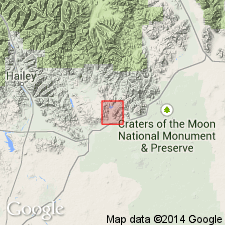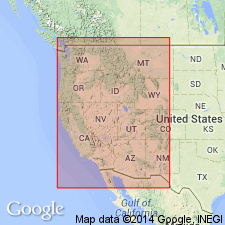
- Usage in publication:
-
- Carey Dolomite*
- Modifications:
-
- Named
- Dominant lithology:
-
- Dolomite
- AAPG geologic province:
-
- Snake River basin
Summary:
Named for the town of Carey, 10 mi southwest of Fish Creek Reservoir, Blaine Co, ID in the Snake River basin. Type section measured in sec 10, T1N, R22E where the Carey is 485+ ft thick; its lower contact is covered by colluvium and lake sediments; its upper contact is a normal fault that separates Carey from younger Jefferson Formation. Geologic map, columnar section. Divided at type into a lower unit 339+ ft thick and an upper unit 146 ft thick. Is predominantly light-gray to medium-gray dolomite that weathers light to olive gray. Is finely crystalline to aphanitic, has birdseye porosity and contains algal-mat laminae and mud-chip conglomerates, minor dolomite sand, and granule to pebble conglomerate. Recrystallized corals and brachiopods found in uppermost unit, corals and crinoid ossicles scattered through some of the lower units. Has conodonts (listed) of Eifelian or early Middle Devonian age. Conodont fauna at one locality of Emsian?, late Early Devonian age. Is a shelf-facies rock.
Source: GNU records (USGS DDS-6; Denver GNULEX).

- Usage in publication:
-
- Carey Dolostone*
- Modifications:
-
- Redescribed
- Dominant lithology:
-
- Dolostone
- AAPG geologic province:
-
- Snake River basin
Summary:
Fig. 2 (stratigraphic column of north-central Utah). Carey Dolostone. Unconformably overlies Beartooth Butte Formation (Lower Devonian); conformably underlies Jefferson Formation (Middle and Upper Devonian). Age is Early Devonian (Emsian).
[In fig. 2 and throughout chapter, "dolostone" is used for rocks composed predominantly of the mineral "dolomite." Although "dolostone" is the proper term, it has not often been applied to dolomitic formations and members; historically, common practice in the literature has been the use of "dolomite."]
Source: Modified from GNU records (USGS DDS-6; Denver GNULEX).
For more information, please contact Nancy Stamm, Geologic Names Committee Secretary.
Asterisk (*) indicates published by U.S. Geological Survey authors.
"No current usage" (†) implies that a name has been abandoned or has fallen into disuse. Former usage and, if known, replacement name given in parentheses ( ).
Slash (/) indicates name conflicts with nomenclatural guidelines (CSN, 1933; ACSN, 1961, 1970; NACSN, 1983, 2005, 2021). May be explained within brackets ([ ]).

